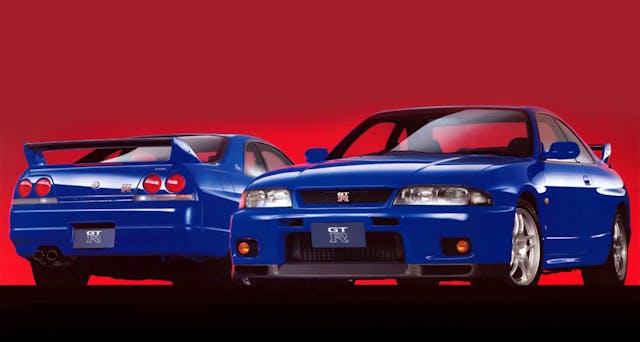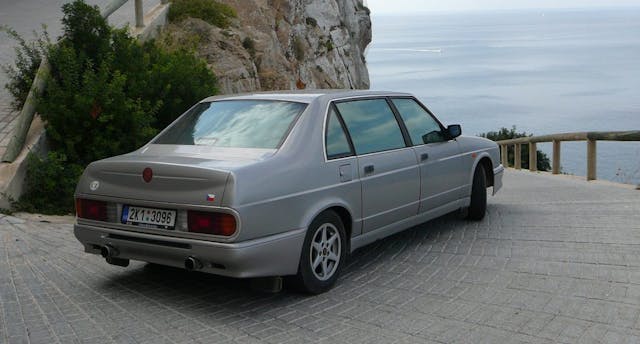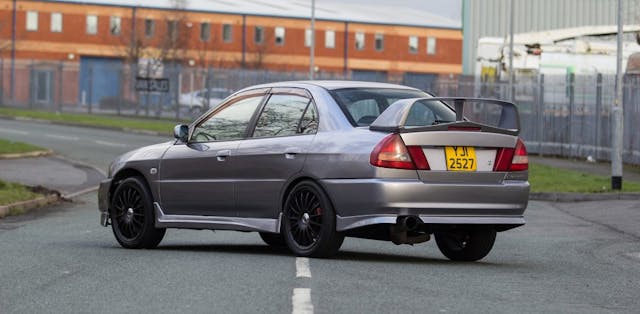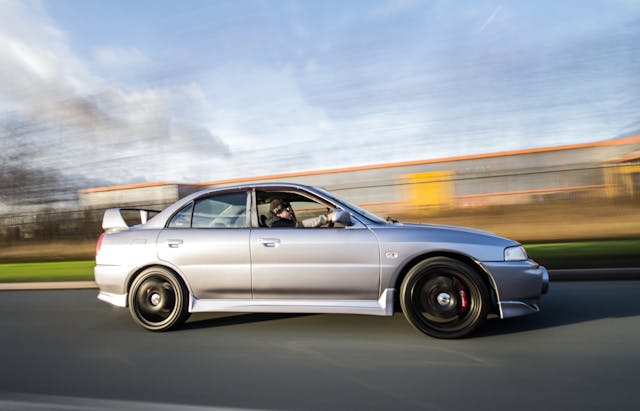8 amazing cars you can import in 2021 under the 25-year rule
We have a certain rule here in the States, and it’s often frustrating. To get an exemption from the various forms and regulations that allow a car to be registered here, the Department of Transportation requires vehicles to be 25 years or older. That means we’ve had to watch with envy from afar as enthusiasts in Europe, Japan, and elsewhere enjoy cars that are effectively unobtainium for us, at least until the clock runs down on them. Our neighbors up north, in Canada, also have a 10-year head start on us with their own 15-year import rule.
If there’s a silver lining to the 25-year rule, it’s that every 12 months we get a crop of classic cars that are, to us anyway, fresh and exotic. Exemptions are also granted according to a car’s production date rather than model year, which means there is a rolling list of vehicles that become newly available as the months press on.
Below are eight cars we’ve had an eye on from the class of 1996 that will be eligible to import at some point in 2021. Keep in mind, however, that your results may vary depending on what state you live in. If you want to register one of these cars in California, for example, you’re out of luck.
Lotus Elise (Series 1)

Lotus brought the Series 2 Elise to our shores in 2005, although it took some safety exemptions from the Feds to get it here (thanks, NHTSA!). This was the most exciting new Lotus we’d seen in a generation, but across the pond the Elise had already been a track day and back-road favorite for nearly a decade.
Initially intended as a limited-run vehicle to promote Lotus Engineering (the part of the company that actually made money), the Elise was the car with which Lotus finally moved away from the backbone chassis. Instead, Lotus designed and patented a system for building a frame out of bonded extruded aluminum that is both very light and very strong. Also, no rust.

Cutting-edge chassis aside, the rest of the car was a back-to-basics package in the classic Lotus tradition—fiberglass body, no-frills interior, a small smiley-faced grille, and of course some parts bin bits like Rover Metro mirrors and Peugeot switchgear. The 1.8-liter Rover K-series four, also found in the MGF, provided 118 horsepower in a car weighing fewer than 1800 pounds. These were the days when Romano Artioli, who also owned Bugatti, was the boss at Lotus. He kept with the tradition of Lotus road cars by giving the new model a name starting “E,” but did so with a personal touch. Elise was the name of his granddaughter.
Artioli also pushed the unveiling of the Elise ahead a month, for the Frankfurt Motor Show in September 1995 instead of the London show in October. Upon its debut, the Elise struck just the right balance between hardcore roadster and usable driver with enthusiasts, and it went on to become the company’s best-selling model ever. Lotus sold over 10,000 Series 1 Elises from 1996–2000, but that original version never had a chance of passing U.S. safety regulations.
That won’t matter starting next year, however, and you can get an original Elise shipped from the U.K., E.U., or Canada. Just remember that these are 25-year-old cars that were often driven hard, and that the Rover K-series has known head gasket issues.
Renault Sport Spider

A bare-bones bug-eyed racer for the road, the Sport Spider hails from the country that does automotive oddities better than any other: France. Built from 1996-99 at the Alpine factory in Dieppe, the Sport Spider came with an aluminum chassis, plastic composite body, a rollbar, and that’s about it. If you wanted to keep the bugs out of your teeth, you had to pay extra for a windshield. Same for a radio.
At 2050 pounds with a 148-hp, 2.0-liter four from the Clio Williams and a five-speed manual, the Sport Spider can hit 60 in less than six seconds, but you buy a car like this because it’s a corner carver, not to win any drag races. (And because it’s French high-performance at its weirdest, and possibly best.) Renault sold about 1800 of these cars and they mostly stayed in Europe, although a few have made it to Canada.
Nissan Skyline GT-R LM Limited

R33 Skylines became eligible to import last year, and boatloads of them have already pulled into port for eager American JDM fans. If you’re already lusting after an R34 you’ll unfortunately have to wait until 2024 to bring one in, but there are a few special editions of the R33 GT-R (1995–98) coming down the pipeline that might be of interest. One, built very briefly in the spring of 1996, is the GT-R “LM Limited.”
The GT-R isn’t known as a Le Mans winner, mainly because it wasn’t. Despite four tries with the R33 GT-R, Nissan never could eke out a class win at La Sarthe with Godzilla, despite the car’s domination elsewhere. Nevertheless, Nissan celebrated its efforts at Le Mans by selling 188 GT-Rs in LM Limited Trim. All wore Championship Blue, featured special decals, and got a carbon spoiler blade as well as different cooling ducts and bonnet lip.
Tatra 700

Tatra built some of the world’s most advanced and interesting cars in the 1930s, and although the Czech company mostly paid its bills by selling heavy trucks, it had a decent side hustle building limousines for Party bigwigs during the communist years. For decades, the formula for Tatra cars didn’t change much. They typically featured a distinct shape, a rear-mounted air-cooled V-8, and a roomy interior. The T700, which turns 25 next year, has all of the above. It also bears the unfortunate distinction of being the very last Tatra.
By the time the 1990s arrived, Tatra remained an independent company and was selling trucks, but it didn’t quite have the funds to develop an all-new car. Instead, Tatra opted to overhaul its 613 model that dated way back to 1974. All hand-built, these T700s feature a 3.5-liter air-cooled and Bosch fuel-injected V-8, a five-speed manual transaxle, and pleasing walnut trim on the dash.
Unfortunately, the T700 wasn’t much of a hit. Many Czech buyers, now free to buy Western cars, preferred something like a Mercedes or BMW. Tatra built fewer than 100 T700s, and in 1999 the company ended car production after a 102-year run, to focus on the truck side of the operation. Good luck finding one, but if you do, you’ll have a friend waiting. There is one lone T700 that somehow made it to the U.S. already, and it’s at the Lane Motor Museum in Nashville.
Toyota Classic

In 1996, Toyota had a big birthday to celebrate. It had been 60 years since the company built its first automobile, called the AA. According to Toyota, it was also the first all-Japanese-built passenger car. While not a groundbreaking design (the engine was copied from Chevrolet and the body aped from DeSoto’s Airflow) it was still a big milestone for what would become the world’s largest carmaker.
Given that this was ‘90s Japan and retro-styled cars were in vogue, Toyota marked the occasion with the aptly named “Classic,” a modern take on the car that started it all. Toyota sold just 100 examples, all in two-tone black and dark red with a wood-rim steering wheel, wood trim, woodgrain dashboard, and leather seats. And although it looks like a ‘30s sedan on top, the Classic is all Toyota Pickup (a.k.a Tacoma) underneath.
It’s not exactly pretty. Certainly not fast, and probably not fun to drive, either. It is, however, an ultra-rare piece of Toyota history, and as of next year you can have one. It will definitely be the only one in town.
TVR Cerbera

We recently featured the Cerbera on our list of the craziest factory steering wheels, but the rest of this car is just as wild. Of course it is, because TVR made it. The doors don’t open with handles, but by small buttons under the mirrors, and from inside you open them with buttons in the door pockets. The rest of the swoopy, leather- and aluminum-trimmed interior looks like something out of Star Trek. As for that steering wheel, it has two minor gauges sitting below the column, along with buttons that operate the wipers and horn. There’s also a large air vent in the middle pointing right at your face, handy on a hot day. And that’s just the interior.
The Cerbera, named for Cerberus, the three-headed dog that guards the Underworld in Greek mythology, was TVR’s flagship model during some of the company’s best years. Autocar called it “one of the fastest, hardest production cars ever made.” It was also the first TVR to use the company’s proprietary engines, bringing with it significant pluses and minuses. The so-called “AJP” (named for designers Al Meling, John Ravenscroft, and Peter Wheeler) engine is a compact, racy 75-degree V-8 with a flat-plane crank and forged pistons and rods. In the Cerbera, it ranged from 4.2 to 4.5 liters and from 360 to 440 horsepower in a 2+2 coupe weighing less than 2500 pounds. That’s about 800 pounds less than a Viper GTS, by the way. TVR also sold a few Cerberas with its 4.0-liter “Speed Six” straight-six, which itself was far from a wimp at 350 hp.
The minuses? Well, TVR engines were something of a ticking time bomb if not carefully maintained. Some lasted just 20,000 miles before needing a rebuild, and something as simple as an alternator replacement is an engine-out affair. Being a TVR, rust is also a concern, as the exhaust runs along the top of the backbone and can trap condensation in difficult-to-see areas. Also, good luck finding TVR parts and specialists here in the States.
If you want to play it safe(r), previous TVRs like the Chimaera and Griffith are already eligible to import, and they use the tried-and-true Rover V-8 under the hood.
Nissan Stagea

We can never have enough fast wagons, and next year we’ll get one more: the Nissan Stagea. When Nissan debuted in 1996, it aimed this car straight at the Subaru Legacy. Underneath this car is a lot more interesting than it sounds; the Stagea shares lots of parts with the R33 Skyline. Because of that, many of the common upgrades for the Skyline also work on the Stagea.
All Stageas got a version of Nissan’s famous RB-series straight-six, from a 2.0-liter normally aspirated version all the way up to the legendary 2.6-liter RB26DETT from the GT-R. The hottest version from both a collectibility and performance standpoint is the 260RS sold by tuning company Autech. In turning the Stagea into something like a five-door GT-R, Autech took top-spec Stageas using the RB26DETT, five-speed, and ATTESA E-TS all-wheel drive system from the GT-R. Then came Brembo brakes, BBS forged alloys, handling upgrades, a GT-R steering wheel, and other interior improvements. Otherwise, most people bought their Stagea with all-wheel drive (rear-drive was available), a four-speed automatic, and a less potent engine.
Finding a clean, unmodified (or lightly) modified Stagea from overseas won’t be easy, but if you do you’ll have yourself a real JDM unicorn. We say unicorn, in particular, because of the Stagea’s super cool badge. It’s two unicorns arranged to form the letter “S.”
Mitsubishi Lancer Evolution IV

Americans didn’t see a Lancer Evolution in the showrooms until the Evo VIII of 2003, but we were keenly aware of what remained out of reach. This all-wheel-drive dynamo had already been making a name for itself for a decade on the road, on the stages of the World Rally Championship, and in video games like Gran Turismo.
In 2021, the Evo IV will be the next one eligible for import. Compared to the Evo III, the IV got a larger intercooler and new twin-scroll turbo for more power out of its 2.0-liter 4G63T engine. It also got newly designed multi-link rear suspension. The Evo IV was also the first to use Active Yaw Control to enhance cornering performance and braking stability, and its taillight design would become a signature feature on future Lancer Evolutions.
The Evo IV came in either RS or GSR trim. The RS was essentially a bare-bones version built to meet homologation rules for the World Rally Championship, and the Evo IV definitely has some rally pedigree going for it. Tommi Mäkinen won the 1997 WRC Driver’s title in an Evo IV, beating Colin McRae by a single point (Subaru won the Manufacturers’ title). The GSR model, meanwhile, was the more proper road car with more creature comforts and sharper-looking alloy wheels.
The Evo IV didn’t debut until August 1996, so it’ll be a while yet before you can import one, but it isn’t too early to start looking. Mitsubishi only built 9000 examples, and many have been drifted or driven to their doom by now.


